Amsterdam and Poland 2017 
Day 7, Warsaw
Saturday, June 10
After another delicious breakfast, our group gathered on our coach for
our first adventure. As in the past, when we had taken a tour, we were
given little receivers and earplugs. They call them " whispers". In most
cities, a regular a city guide has to give the tour, so this very nice
lady gave us many hours, on and off the bus, of interesting Polish
history, especially about Warsaw.
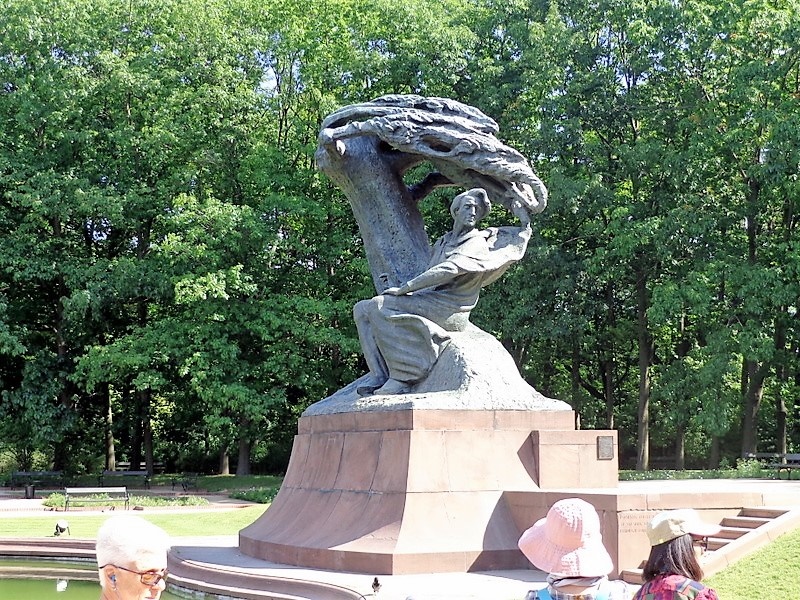 Our first stop was a very large park, Royal LaZienk Park, which is
the park in Warsaw, occupying 76 acres of the city center. Originally
designed in the 17th century as a baths park. In the 18th century
ŁaZienki was transformed by Poland’s King Stanislaw August into a
setting for palaces, villas, and monument. In 1918, it was officially
designated a public park. While the Germans ruled the area of Poland
only Germans were allowed in the pool in the park. The park contained a
huge statue of Chopin and several large royal palaces.
Our first stop was a very large park, Royal LaZienk Park, which is
the park in Warsaw, occupying 76 acres of the city center. Originally
designed in the 17th century as a baths park. In the 18th century
ŁaZienki was transformed by Poland’s King Stanislaw August into a
setting for palaces, villas, and monument. In 1918, it was officially
designated a public park. While the Germans ruled the area of Poland
only Germans were allowed in the pool in the park. The park contained a
huge statue of Chopin and several large royal palaces.
THE CHOPIN STATUE
The Chopin Statue is a large bronze statue
of Frederick Chopin that now stands in the upper part of the park. It
was designed in 1907 to be erected on the hundredth anniversary of
Chopin's birth outside of Warsaw in 1810, but its execution was delayed
by controversy about the design, then by the outbreak of World War I. The
statue was finally cast and erected in 1926.
During World War II, the statue was blown up on May 31, 1940. It was
the first monument that was destroyed by the occupying Germans in
Warsaw.
The original mold for the statue, which had survived the war, made
it possible to cast a replica, which was placed at the original site in
1958. Since 1959, on summer Sunday afternoo ns free piano recitals of
Chopin's compositions are performed on a stage at the base of the
statue.
ns free piano recitals of
Chopin's compositions are performed on a stage at the base of the
statue.
The stylized Willow tree over Chopin's seated figure resembles a
pianist's hand and fingers.
We walked through the park, which contain several beautiful palaces.
The bus was waiting for us on the other side.
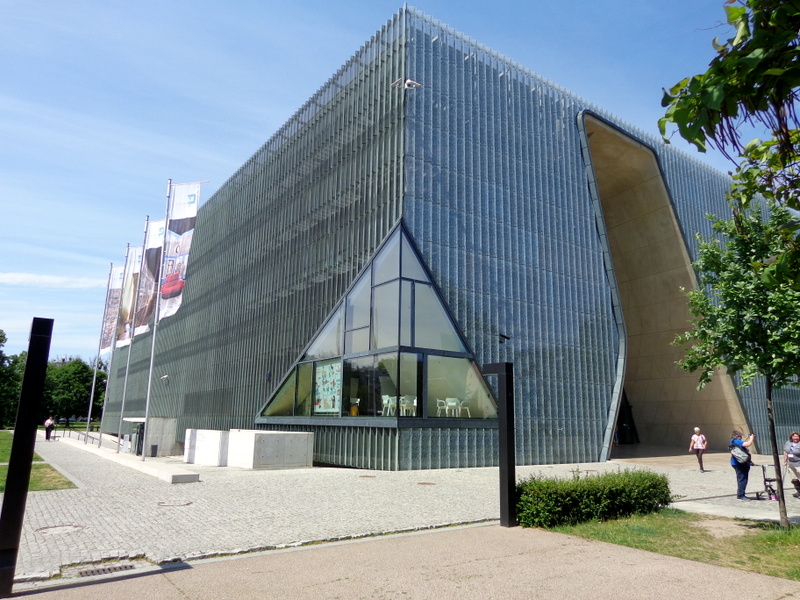
From the park, we went to the Polin Museum where we went
yesterday; however, today we didn't go inside. The city guide told us
all about the Jewish ghetto and much of the history that we saw
illustrated so well in the museum.
Next, we made a brief stop at the Warsaw Uprising monument.
There was no place for the bus to park so we had view it from inside the
bus. The monument is located on the southern side of Krasinski
Square. In 1999 the building of the Supreme Court of Poland was
constructed in the area directly behind it.
THE WARSAW UPRISING MONUMENT
The Warsaw Uprising Monument
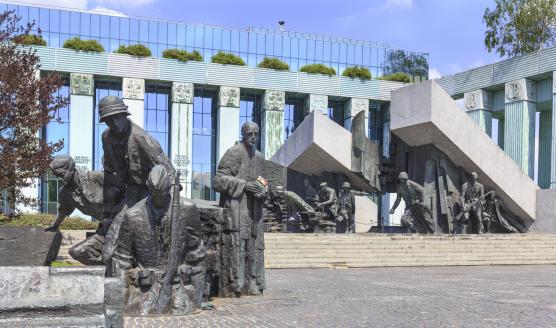 is made from bronze and is
about 33 ft. tall. It is composed of two parts, located within a short
distance of each other. The larger, elevated element shows a group of
insurgents actively engaged in combat, running from a collapsing
building. The smaller element shows insurgents descending into a
manhole – a reference to the use of Warsaw's sewer system by the
insurgents to move across German-held territory during the uprising.
Over 5300 resistance fighters escaped from Warsaw's
Old Town to the city center at the beginning of September 1944. It
was a
five-hour journey which started from Krasiński Square. There is a small
plaque across the road from the monument at the intersection of Długa
and Miodowa streets above the two manholes that were actually used.
is made from bronze and is
about 33 ft. tall. It is composed of two parts, located within a short
distance of each other. The larger, elevated element shows a group of
insurgents actively engaged in combat, running from a collapsing
building. The smaller element shows insurgents descending into a
manhole – a reference to the use of Warsaw's sewer system by the
insurgents to move across German-held territory during the uprising.
Over 5300 resistance fighters escaped from Warsaw's
Old Town to the city center at the beginning of September 1944. It
was a
five-hour journey which started from Krasiński Square. There is a small
plaque across the road from the monument at the intersection of Długa
and Miodowa streets above the two manholes that were actually used.
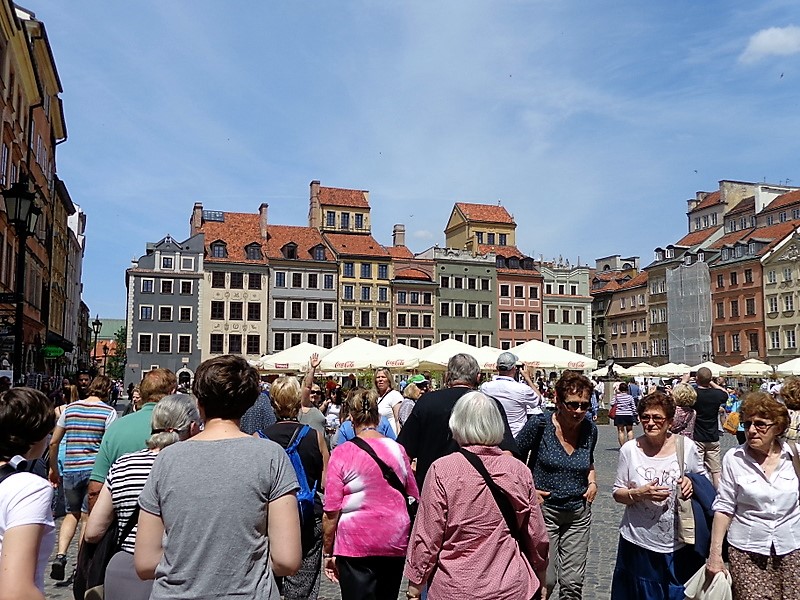 Then the bus took us to Old Town Warsaw which had been completely
destroyed during World War II. It has been restored and is a wonderful
area with a lot to see. Again our guide walked us through the area with
a lot interesting details .
Then the bus took us to Old Town Warsaw which had been completely
destroyed during World War II. It has been restored and is a wonderful
area with a lot to see. Again our guide walked us through the area with
a lot interesting details .
Then we had a lunch break and everyone was
on their own. Most people ate at the same sidewalk café . I had a
wonderful salad of fried shrimp, lettuce, small tomatoes, Parmesan
cheese and capers. Kathleen had salmon wrapped in bacon plus other
interesting vegetables.
. I had a
wonderful salad of fried shrimp, lettuce, small tomatoes, Parmesan
cheese and capers. Kathleen had salmon wrapped in bacon plus other
interesting vegetables.
We were on our own for two hours so we explored several places of
interest to us that were not on the tour, namely several churches.
CITY WALL AND BARBICAN
 The café where we had lunch was close to the City Wall and The
Barbican. In fact, we had to walk through the Barbican that divided the
Old Town from the New Town. The Old Town of Warsaw is ringed by
sections of the old defensive city walls. Construction of the walls
began in the first half of the 14th century and continued until the
mid-16th century. It is possible to walk along the walls through a
special trail running between the inner and outer walls which at one
time served as a moat.
The café where we had lunch was close to the City Wall and The
Barbican. In fact, we had to walk through the Barbican that divided the
Old Town from the New Town. The Old Town of Warsaw is ringed by
sections of the old defensive city walls. Construction of the walls
began in the first half of the 14th century and continued until the
mid-16th century. It is possible to walk along the walls through a
special trail running between the inner and outer walls which at one
time served as a moat.

The Barbican is the oldest part of the fortifications. It was built
in 1549 on the site of an earlier gate, probably in response to the
increased threat of invasion. It was to be an important element of
defensive city walls. But its useful life was rather short. Not long
after it had been built, advances in artillery made the Barbican
obsolete, and it was used in actual defense of the city only once- when
the Swedes invaded Warsaw. It was destroyed during World War II. Its
present form is a result of restoration works finished in 1954.
In the New Town, we visited two churches.
THE CHURCH OF THE HOLY SPIRIT
 The first was the
Church of the Holy Spirit located on the left side
of the street shortly after passing through the Barbican Gate. The
church was originally built in the Gothic style alongside a hospital in
the 14th century. It was probably the first hospital of this type in the
region. From 1425 it was a hostel for the poor and in 1473 a chapel,
temporary accommodation for guests or pilgrims, and a monastery were
added. The parish priest was also the manager of the hospital at that
time.
The first was the
Church of the Holy Spirit located on the left side
of the street shortly after passing through the Barbican Gate. The
church was originally built in the Gothic style alongside a hospital in
the 14th century. It was probably the first hospital of this type in the
region. From 1425 it was a hostel for the poor and in 1473 a chapel,
temporary accommodation for guests or pilgrims, and a monastery were
added. The parish priest was also the manager of the hospital at that
time.
During the Swedish invasion (commonly referred to as The Deluge) the
church fell into ruin and subsequently burnt down, but the magistrate's
resolution from 1664 ensured that the hospital had an income.
In 1699 the foundation stone was laid for the new church, which was
built from 1707 to 1717 in Baroque style. The construction of the church
continued until 1746, when the chapel, dedicated to Our Lady of
Czestochowa, was finally completed.
By 1800 there were nine priests as well as two German professors and
four students studying theology in the monastery.
In January 1807, the army of Napole on Bonaparte used the monastery
as army barracks. After the war, the monastery buildings were briefly regained as a
monastery . In 1825 the monastery opened the main seminary as a
theological faculty and later was transferred to the Franciscan order.
The remaining part of the monastery was rented as apartments.
on Bonaparte used the monastery
as army barracks. After the war, the monastery buildings were briefly regained as a
monastery . In 1825 the monastery opened the main seminary as a
theological faculty and later was transferred to the Franciscan order.
The remaining part of the monastery was rented as apartments.
In 1944, during the Warsaw uprising, the church was almost
completely destroyed by the German army; the interior of the church and
vaulting burnt down with only the main altar surviving. The church was
rebuilt in 1956 in the same form as it was before World War II.
ST. HYACINTH’S CHURCH
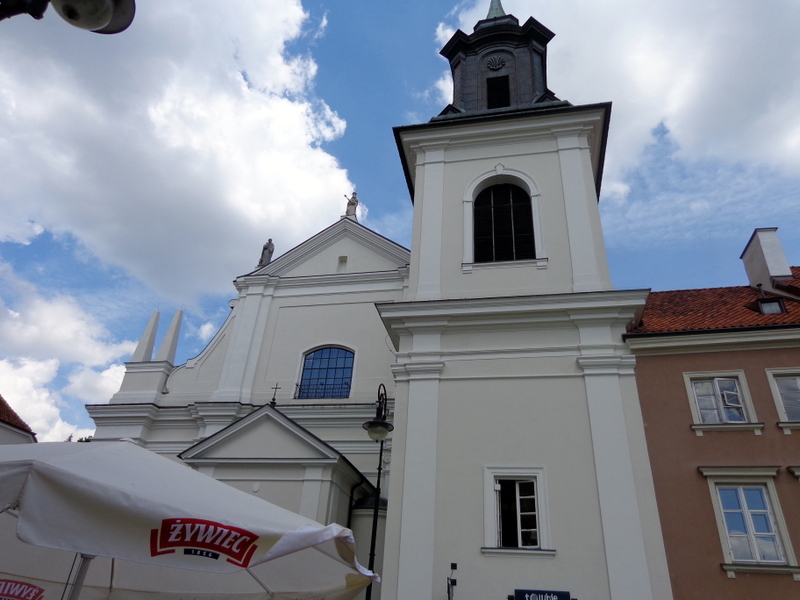 St. Hyacinth's Church was founded by the the Dominican Order and
adjoins Warsaw's largest monastery. The church is a mixture
of Renaissance and early Baroque styles. Its construction began in 1603
and it was completed in 1639.
St. Hyacinth's Church was founded by the the Dominican Order and
adjoins Warsaw's largest monastery. The church is a mixture
of Renaissance and early Baroque styles. Its construction began in 1603
and it was completed in 1639.
During the construction and shortly afterwards the church was
encompassed with ornate chapels.
When Warsaw was captured by Swedish forces in 1655, the church
shared the same fate as other buildings in the city, it was ransacked
and burned. After the war, it was rebuilt and consecrated in 1661.
The 18th century was the age of the church's greatest prosperity.
St Hyacinth's monastery's library
 possessed the richest collection of
volumes in Poland. The library was later destroyed.
possessed the richest collection of
volumes in Poland. The library was later destroyed.
During World War II, the church and monastery served the
Polish forces in the Warsaw Uprising as a field hospital This fact
turned these buildings into targets of frequent bombings by the Germans.
During the bombardments over a thousand civilians and insurgents were
killed.
A plaque near the entrance describes horrific event read “During
the Warsaw uprising this church served as a hospital. The hospital was
actually located in the crypt. The church itself used to provide shelter
to the civilian population during the bombing blitz. In mid-August, the
church was bombed and destroyed. Approximately a thousand people were
killed. The hospital managed to continue to function in the ruined
building until it was taken by the Germans on September 2. The invaders
firstly executed the whole medical staff and blew up the hospital
burying alive about 500 people under the rubble. After the war, it
turned out to be impossible to exhume the remains of all the victims.
Therefore, the ruined crypt was totally covered with a marble floor with
the remains buried underneath.”
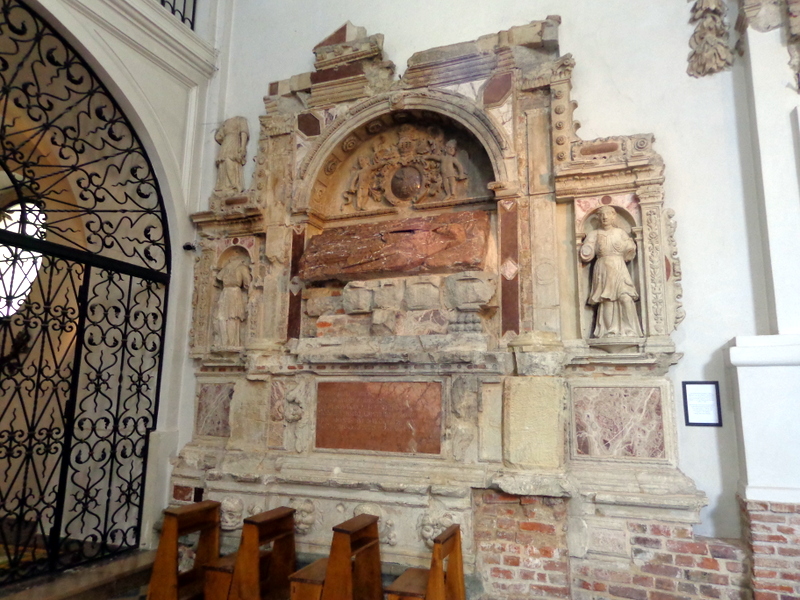 The façade of the church is baroque, although the interior is
completely modern, because very few of the original furnishings of the
church were preserved. Among them, the most interesting are the tomb
monuments. The photo shows the tomb of Anna Tarnowska, carved from
brown Checiny marble in about 1616, which depicts Anna in the typical
Polish sepulchral art sleeping pose. I have been unable to identify
Anna; however, the are several present days ladies with that name.
The façade of the church is baroque, although the interior is
completely modern, because very few of the original furnishings of the
church were preserved. Among them, the most interesting are the tomb
monuments. The photo shows the tomb of Anna Tarnowska, carved from
brown Checiny marble in about 1616, which depicts Anna in the typical
Polish sepulchral art sleeping pose. I have been unable to identify
Anna; however, the are several present days ladies with that name.
We walk back though the Barbican, which had a number of artist
displaying their art work, into the Old Town. The Cathedral was our next
stop.
ST. JOHN'S ARCHCATHEDRAL
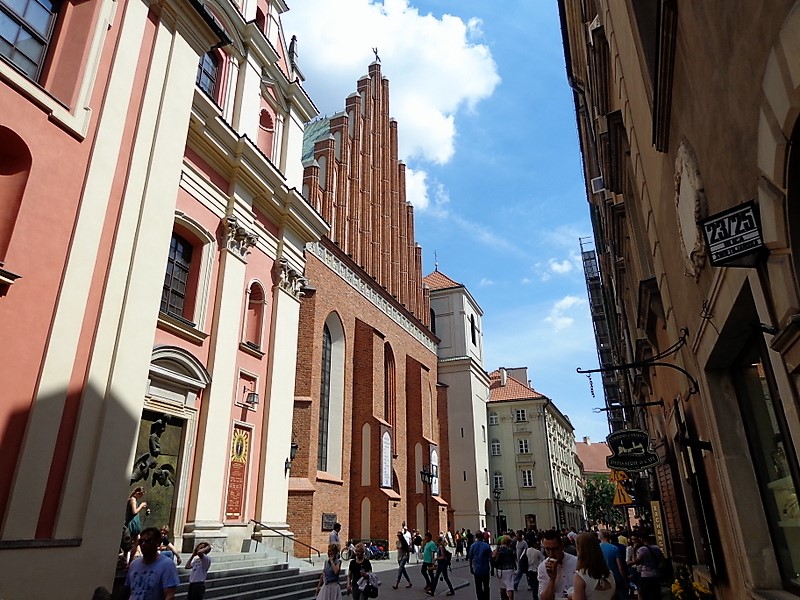 The Cathedral, which wasn't too large, and was wedged in between two
other buildings. The street in front was narrow. It was difficult to
get a full photo of the façade.
The Cathedral, which wasn't too large, and was wedged in between two
other buildings. The street in front was narrow. It was difficult to
get a full photo of the façade.
St. John's Archcathedral is one of three cathedrals in Warsaw,
but the only one which is also an archcathedral. It is the mother church
of the archdiocese of Warsaw. Originally constructed in the 14th
century, the cathedral was the site of royal coronations and burials for
many centuries. During the Warsaw Uprising, (August–October 1944) the
cathedral became a battleground and was blown apart by the Germans. The
Germans managed to drive a tank loaded with explosives into the
Cathedral, and a huge explosion destroyed large part of the
building. After the collapse of the Uprising, German Destruction
Detachment drilled holes into the walls for explosives and blew up the
Cathedral destroying 90% of its walls.
As with many Warsaw landmarks, the cathedral was rebuilt several
times throughout its history. After the war, it was reconstructed based
on its earlier Gothic style rather the Baroque-style structure that had
existed before the war.
Despite the damage inflicted on the building during World War
II, some valuable cathedral artif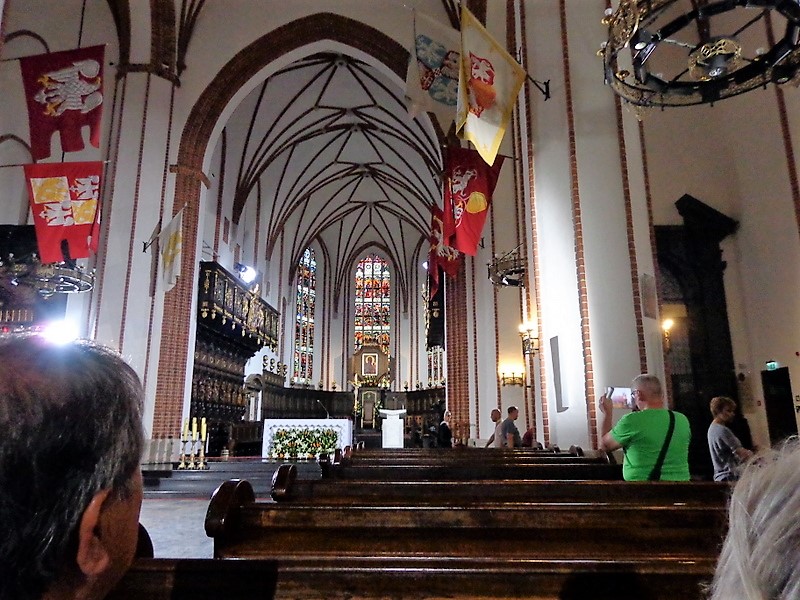 acts have survived, including a
16th-century wooden crucifix.
acts have survived, including a
16th-century wooden crucifix.
Inside, the interior features dark wood and white plaster. The
stained-glass windows, represent important events in Polish history. St.
John’s is not only a place of worship for Warsaw Catholics, but has also
become an important place for sacred music. Organ recitals are often
held here and the church also hosts an annual organ music festival every
summer.
THE ROYAL CASTLE
We walked back to Royal Castle where we were to meet Marta in
 another hour. I have a model kit of the Castle that I have not made
yet. The Royal Castle in Warsaw is a Castle residency that served
throughout the centuries as the official residence of the Polish
monarchs. It is located in the Castle Square, at the entrance to the
Warsaw Old Town . The personal offices of the king and the
administrative offices of the Royal Court of Poland were located there
from the sixteenth century. In its long history the Royal Castle was
repeatedly plundered and devastated by the invading Swedish,
Brandenburgian, Prussian and Tsarist armies. In the 19th century, after
the collapse of the No
another hour. I have a model kit of the Castle that I have not made
yet. The Royal Castle in Warsaw is a Castle residency that served
throughout the centuries as the official residence of the Polish
monarchs. It is located in the Castle Square, at the entrance to the
Warsaw Old Town . The personal offices of the king and the
administrative offices of the Royal Court of Poland were located there
from the sixteenth century. In its long history the Royal Castle was
repeatedly plundered and devastated by the invading Swedish,
Brandenburgian, Prussian and Tsarist armies. In the 19th century, after
the collapse of the No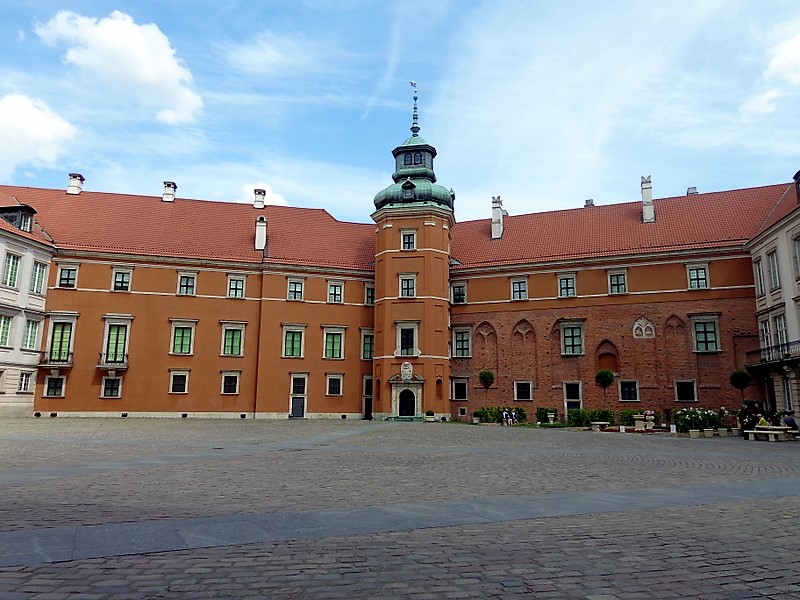 vember Uprising, it was used as an administrative
center by the Tsar and was re-designed for the needs of the Imperial
Russian administration. During the course of World War I, it was the
residence of the German Governor-General. In 1920-1922 the Royal Castle
was the seat of the Polish Head of State and between 1926 and World War
II the building was the residence of the Polish president, Ignacy
Moscicki.
vember Uprising, it was used as an administrative
center by the Tsar and was re-designed for the needs of the Imperial
Russian administration. During the course of World War I, it was the
residence of the German Governor-General. In 1920-1922 the Royal Castle
was the seat of the Polish Head of State and between 1926 and World War
II the building was the residence of the Polish president, Ignacy
Moscicki.
Burned and looted by the Nazi Germans, following the Invasion of
Poland in 1939 and almost completely destroyed in 1944 after the failed
Warsaw Uprising, the Castle was completely rebuilt and reconstructed.
Reconstruction of the castle done in 1971-1984 was led by the Civic
Committee, responsible for the reconstruction of Warsaw. In 1980, the
Royal Castle, together with the Old Town was registered as a protected
UNESCO World Heritage Site.
We only visited the Royal Castle courtyard. We did not have
time to take a tour on the inside.
ST. ANNE'S CHURCH
 Near the Castle was St. Anne's church which was very baroque on the
inside. St. Anne's was reconstructed several times in 1603, 1634, 1636
and in 1667 (it was heavily damaged during the siege of Warsaw and
plundered by Swedish and German troops in the 1650s). Between 1740 and
1760 the façade was reconstructed in rococo style according to Jakub
Fontana’s design and decorated with two filigree belfries. The
walls and semicircular vault ceilings of the church, divided into bays,
were decorated at that time with paintings depicting scenes in the life
of St. Anne. The church was reconstructed for the last time between
1786 and 1788 in a Neoclassical style.
Near the Castle was St. Anne's church which was very baroque on the
inside. St. Anne's was reconstructed several times in 1603, 1634, 1636
and in 1667 (it was heavily damaged during the siege of Warsaw and
plundered by Swedish and German troops in the 1650s). Between 1740 and
1760 the façade was reconstructed in rococo style according to Jakub
Fontana’s design and decorated with two filigree belfries. The
walls and semicircular vault ceilings of the church, divided into bays,
were decorated at that time with paintings depicting scenes in the life
of St. Anne. The church was reconstructed for the last time between
1786 and 1788 in a Neoclassical style.
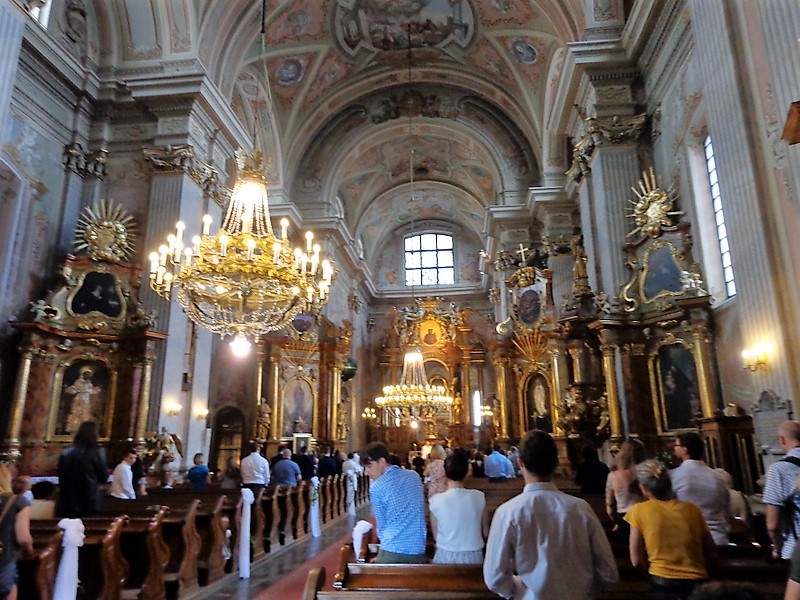
The church was slightly damaged in a German air raid on Warsaw
1939 (the roof and turrets were destroyed by fire and reconstructed).
When we visited, there was a wedding going on and people standing around
the back so we did too. We watched the rest of the wedding then took
photos of the very Baroque interior.
KING SIGIMUND III STATUE
 Near the castle and St. Anne’s church is the famous statue of
Sigismund III. Erected in 1644 to commemorate King Sigismund III Vasa,
this impressive structure honors the ruler, who on the turn of 16th and
17th cent. moved from Kracow to Warsaw. Leveled to the ground during the
Warsaw Uprising (Sep. 2, 1944) and rebuilt after the war (pieces of the
original column, destroyed during WWII, are also on display here). The
statue of the king is original – it fell down however it was not
destroyed.
Near the castle and St. Anne’s church is the famous statue of
Sigismund III. Erected in 1644 to commemorate King Sigismund III Vasa,
this impressive structure honors the ruler, who on the turn of 16th and
17th cent. moved from Kracow to Warsaw. Leveled to the ground during the
Warsaw Uprising (Sep. 2, 1944) and rebuilt after the war (pieces of the
original column, destroyed during WWII, are also on display here). The
statue of the king is original – it fell down however it was not
destroyed.
It is one of War saw’s most famous landmarks and one of the
oldest secular monuments in northern Europe. On the Corinthian column -
28 feet high, a sculpture of the King - 9 feet high, in archaistic
armor stands. Sigismund’s Column now stands 72 feet high and is adorned
by four eagles. The king is dressed in armor and carries a cross in one
hand and wields a sword in the other.
saw’s most famous landmarks and one of the
oldest secular monuments in northern Europe. On the Corinthian column -
28 feet high, a sculpture of the King - 9 feet high, in archaistic
armor stands. Sigismund’s Column now stands 72 feet high and is adorned
by four eagles. The king is dressed in armor and carries a cross in one
hand and wields a sword in the other.
After our wonderful visit to Old Town, our guide took is
back to the hotel in the coach. It was after 4:00 when we got back to
the hotel. Of course, Kathleen took a nap and I closed my eyes several
times. We are quite tired but are now getting ready to go out by
ourselves to eat at a restaurant Kathleen reserved weeks ago.
We had to take a taxi, to a restaurant, Rozanna, It was in
a
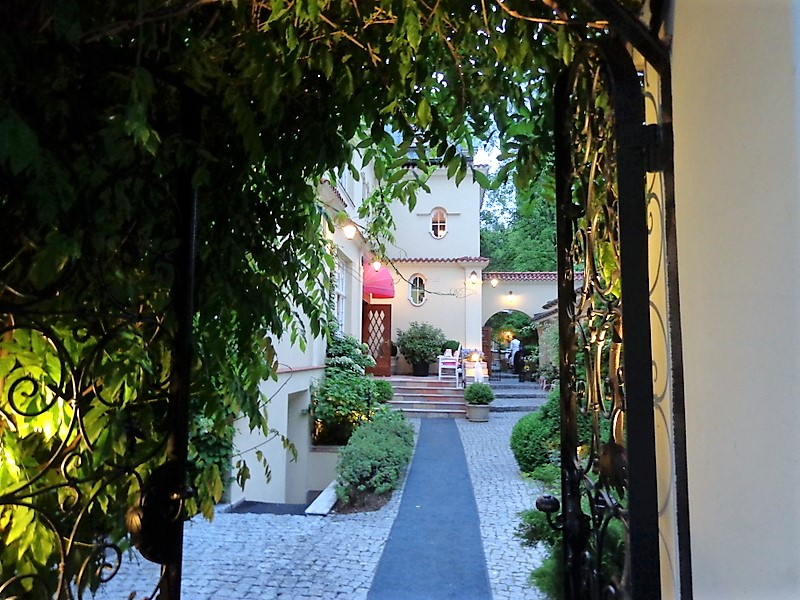 beautiful building with a lovely courtyard. We decided to eat inside
as it was getting a little cool. Kathleen had a cold beet soup, then
catfish with spinach, black lentils and onion sauce. I had veal with
gnocchi and carrots. They had an unbelievable dessert cart. It was a
hard decision. Kathleen had real Polish cheese cake and I had a cheese
cake with fruit. It was a wonderful meal. Small world note: we
beautiful building with a lovely courtyard. We decided to eat inside
as it was getting a little cool. Kathleen had a cold beet soup, then
catfish with spinach, black lentils and onion sauce. I had veal with
gnocchi and carrots. They had an unbelievable dessert cart. It was a
hard decision. Kathleen had real Polish cheese cake and I had a cheese
cake with fruit. It was a wonderful meal. Small world note: we
 were
having lunch with friends when we got home. When we were describing
this restaurant the lady said,” did they have dessert cart surrounded by
flowers?” Said that she had been there, who could forget the dessert
cart and the wonderful dinner?
were
having lunch with friends when we got home. When we were describing
this restaurant the lady said,” did they have dessert cart surrounded by
flowers?” Said that she had been there, who could forget the dessert
cart and the wonderful dinner?
We got a taxi back home. We needed to finish packing as our bags
have to be outside of our door at 6:45 and we have to be on the bus at
7:45. We had a very wonderful time in Warsaw, saw a lot, learned a
lot of history, and WALKED A LOT!
Day 15 coming soon

 Our first stop was a very large park, Royal LaZienk Park, which is
the park in Warsaw, occupying 76 acres of the city center. Originally
designed in the 17th century as a baths park. In the 18th century
ŁaZienki was transformed by Poland’s King Stanislaw August into a
setting for palaces, villas, and monument. In 1918, it was officially
designated a public park. While the Germans ruled the area of Poland
only Germans were allowed in the pool in the park. The park contained a
huge statue of Chopin and several large royal palaces.
Our first stop was a very large park, Royal LaZienk Park, which is
the park in Warsaw, occupying 76 acres of the city center. Originally
designed in the 17th century as a baths park. In the 18th century
ŁaZienki was transformed by Poland’s King Stanislaw August into a
setting for palaces, villas, and monument. In 1918, it was officially
designated a public park. While the Germans ruled the area of Poland
only Germans were allowed in the pool in the park. The park contained a
huge statue of Chopin and several large royal palaces. ns free piano recitals of
Chopin's compositions are performed on a stage at the base of the
statue.
ns free piano recitals of
Chopin's compositions are performed on a stage at the base of the
statue.  is made from bronze and is
about 33 ft. tall. It is composed of two parts, located within a short
distance of each other. The larger, elevated element shows a group of
insurgents actively engaged in combat, running from a collapsing
building. The smaller element shows insurgents descending into a
manhole – a reference to the use of Warsaw's sewer system by the
insurgents to move across German-held territory during the uprising.
Over 5300 resistance fighters escaped from Warsaw's
Old Town to the city center at the beginning of September 1944. It
was a
five-hour journey which started from Krasiński Square. There is a small
plaque across the road from the monument at the intersection of Długa
and Miodowa streets above the two manholes that were actually used.
is made from bronze and is
about 33 ft. tall. It is composed of two parts, located within a short
distance of each other. The larger, elevated element shows a group of
insurgents actively engaged in combat, running from a collapsing
building. The smaller element shows insurgents descending into a
manhole – a reference to the use of Warsaw's sewer system by the
insurgents to move across German-held territory during the uprising.
Over 5300 resistance fighters escaped from Warsaw's
Old Town to the city center at the beginning of September 1944. It
was a
five-hour journey which started from Krasiński Square. There is a small
plaque across the road from the monument at the intersection of Długa
and Miodowa streets above the two manholes that were actually used.  Then the bus took us to Old Town Warsaw which had been completely
destroyed during World War II. It has been restored and is a wonderful
area with a lot to see. Again our guide walked us through the area with
a lot interesting details .
Then the bus took us to Old Town Warsaw which had been completely
destroyed during World War II. It has been restored and is a wonderful
area with a lot to see. Again our guide walked us through the area with
a lot interesting details .  . I had a
wonderful salad of fried shrimp, lettuce, small tomatoes, Parmesan
cheese and capers. Kathleen had salmon wrapped in bacon plus other
interesting vegetables.
. I had a
wonderful salad of fried shrimp, lettuce, small tomatoes, Parmesan
cheese and capers. Kathleen had salmon wrapped in bacon plus other
interesting vegetables. The café where we had lunch was close to the City Wall and The
Barbican. In fact, we had to walk through the Barbican that divided the
Old Town from the New Town. The Old Town of Warsaw is ringed by
sections of the old defensive city walls. Construction of the walls
began in the first half of the 14th century and continued until the
mid-16th century. It is possible to walk along the walls through a
special trail running between the inner and outer walls which at one
time served as a moat.
The café where we had lunch was close to the City Wall and The
Barbican. In fact, we had to walk through the Barbican that divided the
Old Town from the New Town. The Old Town of Warsaw is ringed by
sections of the old defensive city walls. Construction of the walls
began in the first half of the 14th century and continued until the
mid-16th century. It is possible to walk along the walls through a
special trail running between the inner and outer walls which at one
time served as a moat.

 The first was the
Church of the Holy Spirit located on the left side
of the street shortly after passing through the Barbican Gate. The
church was originally built in the Gothic style alongside a hospital in
the 14th century. It was probably the first hospital of this type in the
region. From 1425 it was a hostel for the poor and in 1473 a chapel,
temporary accommodation for guests or pilgrims, and a monastery were
added. The parish priest was also the manager of the hospital at that
time.
The first was the
Church of the Holy Spirit located on the left side
of the street shortly after passing through the Barbican Gate. The
church was originally built in the Gothic style alongside a hospital in
the 14th century. It was probably the first hospital of this type in the
region. From 1425 it was a hostel for the poor and in 1473 a chapel,
temporary accommodation for guests or pilgrims, and a monastery were
added. The parish priest was also the manager of the hospital at that
time.  on Bonaparte used the monastery
as army barracks. After the war, the monastery buildings were briefly regained as a
monastery . In 1825 the monastery opened the main seminary as a
theological faculty and later was transferred to the Franciscan order.
The remaining part of the monastery was rented as apartments.
on Bonaparte used the monastery
as army barracks. After the war, the monastery buildings were briefly regained as a
monastery . In 1825 the monastery opened the main seminary as a
theological faculty and later was transferred to the Franciscan order.
The remaining part of the monastery was rented as apartments.  St. Hyacinth's Church was founded by the the Dominican Order and
adjoins Warsaw's largest monastery. The church is a mixture
of Renaissance and early Baroque styles. Its construction began in 1603
and it was completed in 1639.
St. Hyacinth's Church was founded by the the Dominican Order and
adjoins Warsaw's largest monastery. The church is a mixture
of Renaissance and early Baroque styles. Its construction began in 1603
and it was completed in 1639.  possessed the richest collection of
volumes in Poland. The library was later destroyed.
possessed the richest collection of
volumes in Poland. The library was later destroyed.  The façade of the church is baroque, although the interior is
completely modern, because very few of the original furnishings of the
church were preserved. Among them, the most interesting are the tomb
monuments. The photo shows the tomb of Anna Tarnowska, carved from
brown Checiny marble in about 1616, which depicts Anna in the typical
Polish sepulchral art sleeping pose. I have been unable to identify
Anna; however, the are several present days ladies with that name.
The façade of the church is baroque, although the interior is
completely modern, because very few of the original furnishings of the
church were preserved. Among them, the most interesting are the tomb
monuments. The photo shows the tomb of Anna Tarnowska, carved from
brown Checiny marble in about 1616, which depicts Anna in the typical
Polish sepulchral art sleeping pose. I have been unable to identify
Anna; however, the are several present days ladies with that name. The Cathedral, which wasn't too large, and was wedged in between two
other buildings. The street in front was narrow. It was difficult to
get a full photo of the façade.
The Cathedral, which wasn't too large, and was wedged in between two
other buildings. The street in front was narrow. It was difficult to
get a full photo of the façade.  acts have survived, including a
16th-century wooden crucifix.
acts have survived, including a
16th-century wooden crucifix.  another hour. I have a model kit of the Castle that I have not made
yet. The Royal Castle in Warsaw is a Castle residency that served
throughout the centuries as the official residence of the Polish
monarchs. It is located in the Castle Square, at the entrance to the
Warsaw Old Town . The personal offices of the king and the
administrative offices of the Royal Court of Poland were located there
from the sixteenth century. In its long history the Royal Castle was
repeatedly plundered and devastated by the invading Swedish,
Brandenburgian, Prussian and Tsarist armies. In the 19th century, after
the collapse of the No
another hour. I have a model kit of the Castle that I have not made
yet. The Royal Castle in Warsaw is a Castle residency that served
throughout the centuries as the official residence of the Polish
monarchs. It is located in the Castle Square, at the entrance to the
Warsaw Old Town . The personal offices of the king and the
administrative offices of the Royal Court of Poland were located there
from the sixteenth century. In its long history the Royal Castle was
repeatedly plundered and devastated by the invading Swedish,
Brandenburgian, Prussian and Tsarist armies. In the 19th century, after
the collapse of the No vember Uprising, it was used as an administrative
center by the Tsar and was re-designed for the needs of the Imperial
Russian administration. During the course of World War I, it was the
residence of the German Governor-General. In 1920-1922 the Royal Castle
was the seat of the Polish Head of State and between 1926 and World War
II the building was the residence of the Polish president, Ignacy
Moscicki.
vember Uprising, it was used as an administrative
center by the Tsar and was re-designed for the needs of the Imperial
Russian administration. During the course of World War I, it was the
residence of the German Governor-General. In 1920-1922 the Royal Castle
was the seat of the Polish Head of State and between 1926 and World War
II the building was the residence of the Polish president, Ignacy
Moscicki. Near the Castle was St. Anne's church which was very baroque on the
inside. St. Anne's was reconstructed several times in 1603, 1634, 1636
and in 1667 (it was heavily damaged during the siege of Warsaw and
plundered by Swedish and German troops in the 1650s). Between 1740 and
1760 the façade was reconstructed in rococo style according to Jakub
Fontana’s design and decorated with two filigree belfries. The
walls and semicircular vault ceilings of the church, divided into bays,
were decorated at that time with paintings depicting scenes in the life
of St. Anne. The church was reconstructed for the last time between
1786 and 1788 in a Neoclassical style.
Near the Castle was St. Anne's church which was very baroque on the
inside. St. Anne's was reconstructed several times in 1603, 1634, 1636
and in 1667 (it was heavily damaged during the siege of Warsaw and
plundered by Swedish and German troops in the 1650s). Between 1740 and
1760 the façade was reconstructed in rococo style according to Jakub
Fontana’s design and decorated with two filigree belfries. The
walls and semicircular vault ceilings of the church, divided into bays,
were decorated at that time with paintings depicting scenes in the life
of St. Anne. The church was reconstructed for the last time between
1786 and 1788 in a Neoclassical style.

